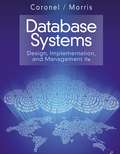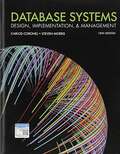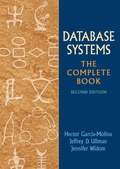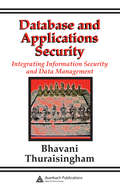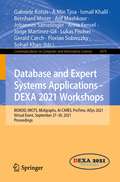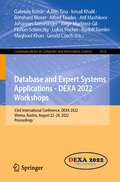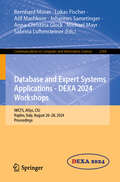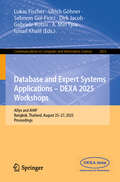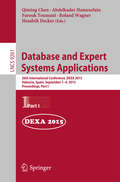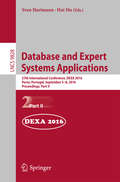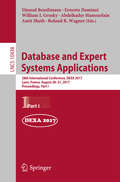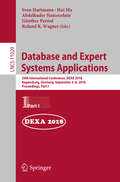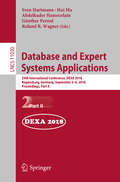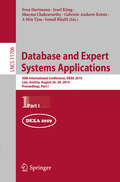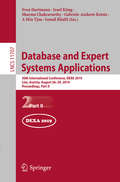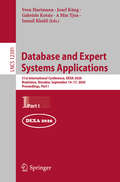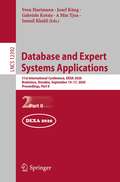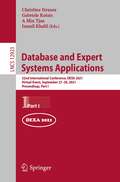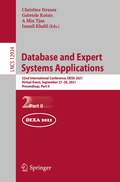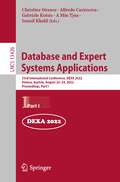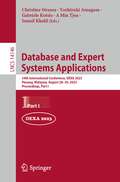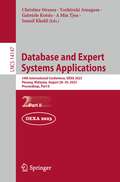- Table View
- List View
Database Systems: Design, Implementation, and Management (Eleventh Edition)
by Steven Morris Carlos CoronelPractical and easy to understand, DATABASE SYSTEMS: DESIGN, IMPLEMENTATION, AND MANAGEMENT, Eleventh Edition, gives students a solid foundation in database design and implementation. Filled with visual aids such as diagrams, illustrations, and tables, this market-leading text provides in-depth coverage of database design, demonstrating that the key to successful database implementation is in proper design of databases to fit within a larger strategic view of the data environment. Renowned for its clear, straightforward writing style, this text provides students with an outstanding balance of theory and practice. The eleventh edition has been updated to include expanded relational algebra coverage, updated business vignettes showing the impact of database tech in the real world, updated coverage of cloud data services, expanded coverage of Big Data and related Hadoop technologies, SQL coverage expanded to include MySQL databases, and many other improvements! In addition, new review questions, problem sets, and cases have been added throughout the book so that students have multiple opportunities to test their understanding and develop real and useful design skills.
Database Systems: Design, Implementation, and Management (Mindtap Course List Series)
by Steven Morris Carlos CoronelDatabase skills are among the most in-demand IT skills today. Now you can gain a solid foundation in database design and implementation with the practical, easy-to-understand approach in the market-leading DATABASE SYSTEMS: DESIGN, IMPLEMENTATION, AND MANAGEMENT, 13E. <p><p>Diagrams, illustrations, and tables clarify in-depth coverage of database design. You learn the key to successful database implementation as you study how to properly design databases to fit within the larger strategic data environment. Clear, straightforward writing supports an outstanding balance of theory and practice with hands-on skills today's employers want. Revised SQL coverage offers more SQL examples and simpler explanations that focus on the areas most important for a database career. More coverage of Big Data Analytics and NoSQL, including related Hadoop technologies, now provides a stronger hands-on approach.
Database Systems: The Complete Book
by Jeffrey D. Ullman Hector Garcia-Molina Jennifer WidomDatabase Systems: The Complete Book is ideal for Database Systems and Database Design and Application courses offered at the junior, senior and graduate levels in Computer Science departments. A basic understanding of algebraic expressions and laws, logic, basic data structure, OOP concepts, and programming environments is implied. <p><p> Written by well-known computer scientists, this introduction to database systems offers a comprehensive approach, focusing on database design, database use, and implementation of database applications and database management systems. <p> The first half of the book provides in-depth coverage of databases from the point of view of the database designer, user, and application programmer. It covers the latest database standards SQL:1999, SQL/PSM, SQL/CLI, JDBC, ODL, and XML, with broader coverage of SQL than most other texts. The second half of the book provides in-depth coverage of databases from the point of view of the DBMS implementor. It focuses on storage structures, query processing, and transaction management. The book covers the main techniques in these areas with broader coverage of query optimization than most other texts, along with advanced topics including multidimensional and bitmap indexes, distributed transactions, and information integration techniques.
Database and Applications Security: Integrating Information Security and Data Management
by Bhavani ThuraisinghamThis is the first book to provide an in-depth coverage of all the developments, issues and challenges in secure databases and applications. It provides directions for data and application security, including securing emerging applications such as bioinformatics, stream information processing and peer-to-peer computing. Divided into eight sections,
Database and Expert Systems Applications - DEXA 2021 Workshops: BIOKDD, IWCFS, MLKgraphs, AI-CARES, ProTime, AISys 2021, Virtual Event, September 27–30, 2021, Proceedings (Communications in Computer and Information Science #1479)
by Ismail Khalil A Min Tjoa Atif Mashkoor Anna Fensel Johannes Sametinger Bernhard Moser Jorge Martinez-Gil Gabriele Kotsis Lukas Fischer Sohail Khan Gerald Czech Florian SobieczkyThis volume constitutes the refereed proceedings of the workshops held at the 32nd International Conference on Database and Expert Systems Applications, DEXA 2021, held in a virtual format in September 2021: The 12th International Workshop on Biological Knowledge Discovery from Data (BIOKDD 2021), the 5th International Workshop on Cyber-Security and Functional Safety in Cyber-Physical Systems (IWCFS 2021), the 3rd International Workshop on Machine Learning and Knowledge Graphs (MLKgraphs 2021), the 1st International Workshop on Artificial Intelligence for Clean, Affordable and Reliable Energy Supply (AI-CARES 2021), the 1st International Workshop on Time Ordered Data (ProTime2021), and the 1st International Workshop on AI System Engineering: Math, Modelling and Software (AISys2021). Due to the COVID-19 pandemic the conference and workshops were held virtually. The 23 papers were thoroughly reviewed and selected from 50 submissions, and discuss a range of topics including: knowledge discovery, biological data, cyber security, cyber-physical system, machine learning, knowledge graphs, information retriever, data base, and artificial intelligence.
Database and Expert Systems Applications - DEXA 2022 Workshops: 33rd International Conference, DEXA 2022, Vienna, Austria, August 22–24, 2022, Proceedings (Communications in Computer and Information Science #1633)
by Ismail Khalil A Min Tjoa Atif Mashkoor Johannes Sametinger Bernhard Moser Jorge Martinez-Gil Gabriele Kotsis Lukas Fischer Gerald Czech Florian Sobieczky Alfred Taudes Rudolf Ramler Maqbool KhanThis volume constitutes the refereed proceedings of the workshops held at the 33rd International Conference on Database and Expert Systems Applications, DEXA 2022, held in Vienna, Austria, in August 2022: The 6th International Workshop on Cyber-Security and Functional Safety in Cyber-Physical Systems (IWCFS 2022); 4th International Workshop on Machine Learning and Knowledge Graphs (MLKgraphs 2022); 2nd International Workshop on Time Ordered Data (ProTime2022); 2nd International Workshop on AI System Engineering: Math, Modelling and Software (AISys2022); 1st International Workshop on Distributed Ledgers and Related Technologies (DLRT2022); 1st International Workshop on Applied Research, Technology Transfer and Knowledge Exchange in Software and Data Science (ARTE2022). The 40 papers were thoroughly reviewed and selected from 62 submissions, and discuss a range of topics including: knowledge discovery, biological data, cyber security, cyber-physical system, machine learning, knowledge graphs, information retriever, data base, and artificial intelligence.
Database and Expert Systems Applications - DEXA 2023 Workshops: 34th International Conference, DEXA 2023, Penang, Malaysia, August 28–30, 2023, Proceedings (Communications in Computer and Information Science #1872)
by Ismail Khalil A Min Tjoa Atif Mashkoor Johannes Sametinger Bernhard Moser Gabriele Kotsis Maqbool KhanThis volume constitutes the refereed proceedings of the workshops held at the 34th International Conference on Database and Expert Systems Applications, DEXA 2023, held in Penang, Malaysia, in August 2023: The 7th International Workshop on Cyber-Security and Functional Safety in Cyber-Physical Systems, IWCFS 2023, and The 3rd International Workshop on AI System Engineering: Math, Modelling and Software, AISys2023. The 7 full papers and 3 short papers were thoroughly reviewed and selected from 20 submissions, and discuss a range of topics including: knowledge discovery, biological data, cyber security, cyber-physical system, machine learning, knowledge graphs, information retriever, data base, and artificial intelligence.
Database and Expert Systems Applications - DEXA 2024 Workshops: IWCFS, AISys, CIU, Naples, Italy, August 26–28, 2024, Proceedings (Communications in Computer and Information Science #2169)
by Atif Mashkoor Johannes Sametinger Bernhard Moser Lukas Fischer Anna-Christina Glock Michael Mayr Sabrina LuftensteinerThis volume constitutes the refereed proceedings of the workshops held at the 35th International Conference on Database and Expert Systems Applications, DEXA 2024, which took place in Naples, Italy, in August 2024. The papers included in this book stem from the following workshops: - 9th International Workshop on Cyber-Security and Functional Safety inCyber-Physical Systems (IWCFS 2024), - 4th International Workshop on AI SystemEngineering: Math, Modelling and Software (AISys 2024), - 2nd InternationalWorkshop on Certainty in Uncertainty: Exploring Probabilistic Approaches in AI (CIU2024) The 10 full papers and 5 short papers were thoroughly reviewed and selected from a total of 24 submissions. They were organized in topical sections as follows: Cyber-security and functional safety in cyber-physical systems; AI system engineering: math, modelling, and software; certainty in uncertainty: exploring probabilistic approaches in AI.
Database and Expert Systems Applications - DEXA 2025 Workshops: AISys and AI4IP, Bangkok, Thailand, August 25–27, 2025, Proceedings (Communications in Computer and Information Science #2615)
by Ismail Khalil A Min Tjoa Gabriele Kotsis Lukas Fischer Ulrich Göhner Sebnem Gül-Ficici Dirk JacobThis volume constitutes the refereed proceedings of the 7th International Workshop on AI System Engineering: Math, Modelling and Software, AISys 2025 and the First International Workshop on Optimisation of Industrial Production with AI Algorithms, AI4IP, co-located with the 36th International Conference on Database and Expert Systems Applications, DEXA 2025, which took place in Bangkok, Thailand, during August 25-27, 2025.The 11 full papers were thoroughly reviewed and selected from a total of 23 submissions. They are organized in topical sections as follows: AI System Engineering: Math, Modelling and Software; and Optimization of Industrial Production with AI Algorithms.
Database and Expert Systems Applications: 26th International Conference, DEXA 2015, Valencia, Spain, September 1-4, 2015, Proceedings, Part I (Lecture Notes in Computer Science #9261)
by Abdelkader Hameurlain Roland Wagner Hendrik Decker Farouk Toumani Qiming ChenThis two volume set LNCS 9261 and LNCS 9262 constitutes the refereed proceedings of the 26th International Conference on Database and Expert Systems Applications, DEXA 2015, held in Valencia, Spain, September 1-4, 2015. The 40 revised full papers presented together with 32 short papers, and 2 keynote talks, were carefully reviewed and selected from 125 submissions. The papers discuss a range of topics including: temporal, spatial and high dimensional databases; semantic Web and ontologies; modeling, linked open data; NoSQLm NewSQL, data integration; uncertain data and inconsistency tolerance; database system architecture; data mining, query processing and optimization; indexing and decision support systems; modeling, extraction, social networks; knowledge management and consistency; mobility, privacy and security; data streams, Web services; distributed, parallel and cloud databases; information retrieval; XML and semi-structured data; data partitioning, indexing; data mining, applications; WWW and databases; data management algorithms. These volumes also include accepted papers of the 8th International Conference on Data Management in Cloud, Grid and P2P Systems, Globe 2015, held in Valencia, Spain, September 2, 2015. The 8 full papers presented were carefully reviewed and selected from 13 submissions. The papers discuss a range of topics including: MapReduce framework: load balancing, optimization and classification; security, data privacy and consistency; query rewriting and streaming.
Database and Expert Systems Applications: 27th International Conference, DEXA 2016, Porto, Portugal, September 5-8, 2016, Proceedings, Part II (Lecture Notes in Computer Science #9828)
by Sven Hartmann Hui MaThis two volume set LNCS 9827 and LNCS 9828 constitutes the refereed proceedings of the 27th International Conference on Database and Expert Systems Applications, DEXA 2016, held in Porto, Portugal, September 2016. The 39 revised full papers presented together with 29 short papers were carefully reviewed and selected from 137 submissions. The papers discuss a range of topics including: Temporal, Spatial, and High Dimensional Databases; Data Mining; Authenticity, Privacy, Security, and Trust; Data Clustering; Distributed and Big Data Processing; Decision Support Systems, and Learning; Data Streams; Data Integration, and Interoperability; Semantic Web, and Data Semantics; Social Networks, and Network Analysis; Linked Data; Data Analysis; NoSQL, NewSQL; Multimedia Data; Personal Information Management; Semantic Web and Ontologies; Database and Information System Architectures; Query Answering and Optimization; Information Retrieval, and Keyword Search; Data Modelling, and Uncertainty.
Database and Expert Systems Applications: 28th International Conference, DEXA 2017, Lyon, France, August 28-31, 2017, Proceedings, Part I (Lecture Notes in Computer Science #10438)
by Djamal Benslimane, Ernesto Damiani, William I. Grosky, Abdelkader Hameurlain, Amit Sheth and Roland R. WagnerThis two volume set LNCS 10438 and LNCS 10439 constitutes the refereed proceedings of the 28th International Conference on Database and Expert Systems Applications, DEXA 2017, held in Lyon, France, August 2017. The 37 revised full papers presented together with 40 short papers were carefully reviewed and selected from 166 submissions. The papers discuss a range of topics including: Semantic Web and Semantics; Graph Matching; Data Modeling, Data Abstraction, and Uncertainty; Preferences and Query Optimization; Data Integration and RDF Matching; Security and Privacy; Web Search; Data Clustering; Top-K and Skyline Queries; Data Mining and Big Data; Service Computing; Continuous and Temporal Data, and Continuous Query Language; Text Processing and Semantic Search; Indexing and Concurrency Control Methods; Data Warehouse and Data Stream Warehouse; Data Mining and Machine Learning; Recommender Systems and Query Recommendation; Graph Algorithms; Semantic Clustering and Data Classification.
Database and Expert Systems Applications: 28th International Conference, DEXA 2017, Lyon, France, August 28-31, 2017, Proceedings, Part II (Lecture Notes in Computer Science #10439)
by Djamal Benslimane, Ernesto Damiani, William I. Grosky, Abdelkader Hameurlain, Amit Sheth and Roland R. WagnerThis two volume set LNCS 10438 and LNCS 10439 constitutes the refereed proceedings of the 28th International Conference on Database and Expert Systems Applications, DEXA 2017, held in Lyon, France, August 2017. The 37 revised full papers presented together with 40 short papers were carefully reviewed and selected from 166 submissions. The papers discuss a range of topics including: Semantic Web and Semantics; Graph Matching; Data Modeling, Data Abstraction, and Uncertainty; Preferences and Query Optimization; Data Integration and RDF Matching; Security and Privacy; Web Search; Data Clustering; Top-K and Skyline Queries; Data Mining and Big Data; Service Computing; Continuous and Temporal Data, and Continuous Query Language; Text Processing and Semantic Search; Indexing and Concurrency Control Methods; Data Warehouse and Data Stream Warehouse; Data Mining and Machine Learning; Recommender Systems and Query Recommendation; Graph Algorithms; Semantic Clustering and Data Classification.
Database and Expert Systems Applications: 29th International Conference, DEXA 2018, Regensburg, Germany, September 3–6, 2018, Proceedings, Part I (Lecture Notes in Computer Science #11029)
by Abdelkader Hameurlain Sven Hartmann Hui Ma Günther Pernul Roland R. WagnerThis two volume set of LNCS 11029 and LNCS 11030 constitutes the refereed proceedings of the 29th International Conference on Database and Expert Systems Applications, DEXA 2018, held in Regensburg, Germany, in September 2018. The 35 revised full papers presented together with 40 short papers were carefully reviewed and selected from 160 submissions. The papers of the first volume discuss a range of topics including: Big data analytics; data integrity and privacy; decision support systems; data semantics; cloud data processing; time series data; social networks; temporal and spatial databases; and graph data and road networks. The papers of the second volume discuss a range of the following topics: Information retrieval; uncertain information; data warehouses and recommender systems; data streams; information networks and algorithms; database system architecture and performance; novel database solutions; graph querying and databases; learning; emerging applications; data mining; privacy; and text processing.
Database and Expert Systems Applications: 29th International Conference, DEXA 2018, Regensburg, Germany, September 3–6, 2018, Proceedings, Part II (Lecture Notes in Computer Science #11030)
by Abdelkader Hameurlain Sven Hartmann Hui Ma Günther Pernul Roland R. WagnerThis two volume set of LNCS 11029 and LNCS 11030 constitutes the refereed proceedings of the 29th International Conference on Database and Expert Systems Applications, DEXA 2018, held in Regensburg, Germany, in September 2018.The 35 revised full papers presented together with 40 short papers were carefully reviewed and selected from 160 submissions. The papers of the first volume discuss a range of topics including: Big data analytics; data integrity and privacy; decision support systems; data semantics; cloud data processing; time series data; social networks; temporal and spatial databases; and graph data and road networks. The papers of the second volume discuss a range of the following topics: Information retrieval; uncertain information; data warehouses and recommender systems; data streams; information networks and algorithms; database system architecture and performance; novel database solutions; graph querying and databases; learning; emerging applications; data mining; privacy; and text processing.
Database and Expert Systems Applications: 30th International Conference, DEXA 2019, Linz, Austria, August 26–29, 2019, Proceedings, Part I (Lecture Notes in Computer Science #11706)
by Josef Küng Ismail Khalil A Min Tjoa Sven Hartmann Sharma Chakravarthy Gabriele Anderst-KotsisThis two volume set of LNCS 11706 and LNCS 11707 constitutes the refereed proceedings of the 30th International Conference on Database and Expert Systems Applications, DEXA 2019, held in Linz, Austria, in August 2019. The 32 full papers presented together with 34 short papers were carefully reviewed and selected from 157 submissions. The papers are organized in the following topical sections: Part I: Big data management and analytics; data structures and data management; management and processing of knowledge; authenticity, privacy, security and trust; consistency, integrity, quality of data; decision support systems; data mining and warehousing. Part II: Distributed, parallel, P2P, grid and cloud databases; information retrieval; Semantic Web and ontologies; information processing; temporal, spatial, and high dimensional databases; knowledge discovery; web services.
Database and Expert Systems Applications: 30th International Conference, DEXA 2019, Linz, Austria, August 26–29, 2019, Proceedings, Part II (Lecture Notes in Computer Science #11707)
by Josef Küng Ismail Khalil A Min Tjoa Sven Hartmann Sharma Chakravarthy Gabriele Anderst-KotsisThis two volume set of LNCS 11706 and LNCS 11707 constitutes the refereed proceedings of the 30th International Conference on Database and Expert Systems Applications, DEXA 2019, held in Linz, Austria, in August 2019.The 32 full papers presented together with 34 short papers were carefully reviewed and selected from 157 submissions. The papers are organized in the following topical sections: Part I: Big data management and analytics; data structures and data management; management and processing of knowledge; authenticity, privacy, security and trust; consistency, integrity, quality of data; decision support systems; data mining and warehousing. Part II: Distributed, parallel, P2P, grid and cloud databases; information retrieval; Semantic Web and ontologies; information processing; temporal, spatial, and high dimensional databases; knowledge discovery; web services.
Database and Expert Systems Applications: 31st International Conference, DEXA 2020, Bratislava, Slovakia, September 14–17, 2020, Proceedings, Part I (Lecture Notes in Computer Science #12391)
by Josef Küng Ismail Khalil A Min Tjoa Sven Hartmann Gabriele KotsisThe double volumes LNCS 12391-12392 constitutes the papers of the 31st International Conference on Database and Expert Systems Applications, DEXA 2020, which will be held online in September 2020. The 38 full papers presented together with 20 short papers plus 1 keynote papers in these volumes were carefully reviewed and selected from a total of 190 submissions.
Database and Expert Systems Applications: 31st International Conference, DEXA 2020, Bratislava, Slovakia, September 14–17, 2020, Proceedings, Part II (Lecture Notes in Computer Science #12392)
by Josef Küng Ismail Khalil A Min Tjoa Sven Hartmann Gabriele KotsisThe double volumes LNCS 12391-12392 constitutes the papers of the 31st International Conference on Database and Expert Systems Applications, DEXA 2020, which will be held online in September 2020. The 38 full papers presented together with 20 short papers plus 1 keynote papers in these volumes were carefully reviewed and selected from a total of 190 submissions.
Database and Expert Systems Applications: 32nd International Conference, DEXA 2021, Virtual Event, September 27–30, 2021, Proceedings, Part I (Lecture Notes in Computer Science #12923)
by Ismail Khalil A Min Tjoa Christine Strauss Gabriele KotsisThis two-volume set, LNCS 12923 and 12924, constitutes the thoroughly refereed proceedings of the 5th International Conference on Database and Expert Systems Applications, DEXA 2021. Due to COVID-19 pandemic, the conference was held virtually. The 37 full papers presented together with 31 short papers in these volumes were carefully reviewed and selected from a total of 149 submissions. The papers are organized around the following topics: big data; data analysis and data modeling; data mining; databases and data management; information retrieval; prediction and decision support.
Database and Expert Systems Applications: 32nd International Conference, DEXA 2021, Virtual Event, September 27–30, 2021, Proceedings, Part II (Lecture Notes in Computer Science #12924)
by Ismail Khalil A Min Tjoa Christine Strauss Gabriele KotsisThis two-volume set, LNCS 12923 and 12924, constitutes the thoroughly refereed proceedings of the 5th International Conference on Database and Expert Systems Applications, DEXA 2021. Due to COVID-19 pandemic, the conference was held virtually. The 37 full papers presented together with 31 short papers in these volumes were carefully reviewed and selected from a total of 149 submissions. The papers are organized around the following topics: big data; data analysis and data modeling; data mining; databases and data management; information retrieval; prediction and decision support.
Database and Expert Systems Applications: 33rd International Conference, DEXA 2022, Vienna, Austria, August 22–24, 2022, Proceedings, Part I (Lecture Notes in Computer Science #13426)
by Alfredo Cuzzocrea Ismail Khalil A Min Tjoa Christine Strauss Gabriele KotsisThis two-volume set, LNCS 13426 and 13427, constitutes the thoroughly refereed proceedings of the 33rd International Conference on Database and Expert Systems Applications, DEXA 2022, held in Vienna in August 2022.The 43 full papers presented together with 20 short papers in these volumes were carefully reviewed and selected from a total of 120 submissions. The papers are organized around the following topics: Big Data Management and Analytics, Consistency, Integrity, Quality of Data, Constraint Modelling and Processing, Database Federation and Integration, Interoperability, Multi-Databases, Data and Information Semantics, Data Integration, Metadata Management, and Interoperability, Data Structures and much more.
Database and Expert Systems Applications: 33rd International Conference, DEXA 2022, Vienna, Austria, August 22–24, 2022, Proceedings, Part II (Lecture Notes in Computer Science #13427)
by Alfredo Cuzzocrea Ismail Khalil A Min Tjoa Christine Strauss Gabriele KotsisThis two-volume set, LNCS 13426 and 13427, constitutes the thoroughly refereed proceedings of the 33rd International Conference on Database and Expert Systems Applications, DEXA 2022, held in Vienna in August 2022.The 43 full papers presented together with 20 short papers in these volumes were carefully reviewed and selected from a total of 120 submissions. The papers are organized around the following topics: Big Data Management and Analytics, Consistency, Integrity, Quality of Data, Constraint Modelling and Processing, Database Federation and Integration, Interoperability, Multi-Databases, Data and Information Semantics, Data Integration, Metadata Management, and Interoperability, Data Structures and much more.
Database and Expert Systems Applications: 34th International Conference, DEXA 2023, Penang, Malaysia, August 28–30, 2023, Proceedings, Part I (Lecture Notes in Computer Science #14146)
by Ismail Khalil A Min Tjoa Christine Strauss Gabriele Kotsis Toshiyuki AmagasaThe two-volume set, LNCS 14146 and 14147 constitutes the thoroughly refereed proceedings of the 34th International Conference on Database and Expert Systems Applications, DEXA 2023, held in Penang, Malaysia, in August 2023.The 49 full papers presented together with 35 short papers were carefully reviewed and selected from a total of 155 submissions. The papers are organized in topical sections as follows:Part I: Data modeling; database design; query optimization; knowledge representation; Part II: Rule-based systems; natural language processing; deep learning; neural networks.
Database and Expert Systems Applications: 34th International Conference, DEXA 2023, Penang, Malaysia, August 28–30, 2023, Proceedings, Part II (Lecture Notes in Computer Science #14147)
by Ismail Khalil A Min Tjoa Christine Strauss Gabriele Kotsis Toshiyuki AmagasaThe two-volume set, LNCS 14146 and 14147 constitutes the thoroughly refereed proceedings of the 34th International Conference on Database and Expert Systems Applications, DEXA 2023, held in Penang, Malaysia, in August 2023.The 49 full papers presented together with 35 short papers were carefully reviewed and selected from a total of 155 submissions. The papers are organized in topical sections as follows:Part I: Data modeling; database design; query optimization; knowledge representation; Part II: Rule-based systems; natural language processing; deep learning; neural networks.
